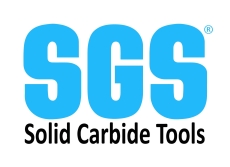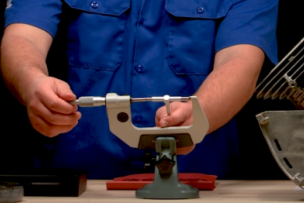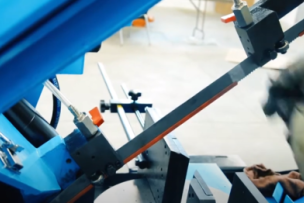Narrator: This video is brought to you by SGS, committed to providing Value at the Spindle®. If you're looking for real world insights, tips from leading industry experts, the latest trends in products and technology, you've come to the right place. From MSC Industrial Supply, this is Tooling Up.
TONI NEARY: Hello and thank you for tuning into Tooling Up. I'm your host Toni Neary, and we are so glad that you're here on the MSC channel. If you're new to the show, be sure to click that subscribe button and like this episode. Today's guest is the R&D and applications engineer at Pete Rak. Pete. Thank you so much for joining us today.
PETE RAK: It's great to be here. Thanks for having us.
TONI NEARY: Absolutely. And now before we jump into the, you know kind of nitty gritty of what we're going to talk about today, you have been with us for 18 years, is that correct?
PETE RAK: That's right.
TONI NEARY: Tell me a little bit about your path there at SGS, how did it start and how did you get to where you are today?
PETE RAK: Well, I actually started as part time here at SGS working as a testing tool technician, as a supplemental job to my full-time job. And after a couple of years doing that, I came on board full time and here I am doing research and development work in customer applications.
TONI NEARY: What type of training courses do you do there at SGS?
PETE RAK: We have clinics. We have more of a basic clinic and a more of an advanced clinic that is a two-and-a-half-day session. We invite our end users and our distributors to them and we train them all about the application and the product that we sell.
TONI NEARY: So you've done a lot, right? You've been on the floor, you've worked in R&D and now engineering, and you're doing training; for anybody who's not familiar with SGS, tell us a little bit about what the company does.
PETE RAK: Well, the SGS part of the Kyocera SGS is solid round carbide cutting tools, so we make drills, end mills, among other things, and they're high-performance tooling. So the metalworking industry, machining industries, we have solutions for all types of applications.
TONI NEARY: Tell us a little bit about what does R&D and engineering look like? What is the purpose? What is the goal when you're doing that?
PETE RAK: Well, it's getting the best solution for the customer. There's a lot of different tooling that's out there, a lot of competitors. We'd like to separate ourselves from the competitors because there are a lot of good toolmakers out there. We like to say that we have a good support system for our customers. We do the training, we do the application work, and the R&D is very, very beneficial for us because we have machines here that we can simulate and replicate what the end user's doing and find the best solution depending on what tool to use, what application.
TONI NEARY: I think that's a perfect segueway into our next topic, which we're really going to dive into today, and that is the difference between high-speed, high-efficiency, as well as high-speed milling technology. Let's kind of start with the basics of milling and metal removal.
PETE RAK: Okay. So let's first define what milling is or machining with milling, and that is going to be using an end mill or such a tool to where you're going to cut the metal with a certain RPM, which is the rotational speed and the feed rate, which is the linear speed. It's going across the material to cut it. And those things are going to involve cut depths, the axial depth and the radial width of cut and the feed rate.
So with a typical heavy cut, you're going to be taking a lot of material away, but at a relatively low feed rate and low speed because you're going to have a lot of factors like load and heat on the tool. High speed comes into play where you're going to take a little bit of a lighter cut or in some cases a lot lighter cut where you can adjust the speed higher and the feed rate higher to compensate for the loss in the radial or axial depth of cut.
This allows you to cut faster, albeit at a lower depth of cut. This can come into play and be beneficial to utilize more of the tool or regarding the flute length or the width of cut. High efficiency is going to take that to a new level where the tool path itself changes to control loads in high load areas, and that's going to be dependent on the geometry of the part you're trying to machine.
And then finally, high feed is going to be using the tool in a totally opposite way of high efficiency, where you're using basically just the tip or face end of the tool and run at very high feed rates. Not necessarily too high of a speed because you're using more of the diameter of the tool, but getting a high feed rate to cut in a different way.
TONI NEARY: I think that makes so much more sense and it really does kind of break it down into the basics. And that's really what we wanted to talk about. And I think that's probably one of the values of working with SGS and MSC is the fact that you're really looking at the entire process, and we have so many new people coming into the industry.
And I know we kind of talked about it, right? Just because somebody is new in the industry doesn't mean that they're not adaptable and they don't have the information. But you may also have people that have been doing the same job for a long time that maybe need to look at new ways. Is that something that you cover in the tool clinics?
PETE RAK: Yeah, that's a really good point, Toni. It's interesting because we have a lot of different experience levels in our clinics and we have people that are seasoned veterans who have been around the industry for 20 plus years, and we have new people who've been in the industry for two months that know nothing about it. So we'd like to cater the clinics to everybody, you know, and sometimes things are a little bit more common knowledge to some people, but we want to have them take away something that they haven't thought of before and a new way of thinking.
So it's really good. And what's interesting with our clinics is that a lot of times the newer people, they come away with a little bit more knowledge than they thought they would.
TONI NEARY: That's fantastic. Do you have any scenarios you could tell us about about a newer team winning and kind of how that folded out in the training?
PETE RAK: Yeah, a lot of things that happen are things that we in R&D learn from these classes. So sometimes they'll suggest a tool or tool path that we've never done before or, and we would think that now that's not going to really work, but we'll try it and we'll show the whole class what's good and what's bad about it.
And when the tool breaks, it's a good thing because we learn, right? We learn what shouldn't work, but sometimes something that we think that's not going to work actually does. And it becomes a new possibility for the future. So we learn a lot here in R&D from our students. So we'd love to conduct these classes just as a learning experience for everybody.
TONI NEARY: Pete, this has been awesome. Thank you so much for your time today. And I mean, I want to come and do an SGS clinic.
PETE RAK: You're more than welcome to. We have lots of them throughout the year.
TONI NEARY: Fantastic. Well, I can't thank you enough for your time and the work that you're doing to really help these manufacturers be more productive, get better tool life, and most importantly, really educate the industry on new and innovative things and kind of doing that muscle work for us behind the scenes there.
PETE RAK: Well, thanks a lot. It's been a pleasure.
TONI NEARY: I'm so glad we had a chance to learn some real insight into high-speed versus high-efficiency versus high-feed milling and where all of those processes are most effective. It's been a great conversation. Don't forget, if you want to find out more and kind of continue the conversation, you can find out more about SGS and their full line of products online at www.mscdirect.com/sgs.
Thank you so much and we'll see you next time on Tooling Up.
Narrator: Want more insights and ideas to improve the efficiency and productivity of your operations? Check out the MSC Tooling Up video playlist to hear tips that can take your company to the next level and subscribe to our channel so you won't miss out.




Talk to Us!
Leave a reply
Your email address will not be published. Required fields are marked *